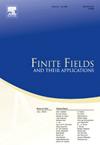与x2η+1+x2η+1相关的二进制多循环码:汉明距离、对偶性、可逆性和LCD性质
IF 1.2
3区 数学
Q1 MATHEMATICS
引用次数: 0
摘要
本文研究了与多项式x2η+1+x2η+1相关的二进制多环码,对于每个η≥1的整数,它是x2+x+1的2η-次幂。我们对这些码进行了深入的结构分析,并计算了每个二进制多环码的精确汉明距离。进一步,我们确定了这些多环码的奇偶校验矩阵,并检验了它们的欧几里得对偶和湮灭对偶。我们的分析表明,这些代码是可逆的,在某些情况下,是线性互补双(LCD)代码。这一发现突出了这些代码在通信系统、数据存储、消费电子和密码学等实际应用中的潜力。我们还提出了一个猜想,表明所有这些多循环码都可以是LCD。本文章由计算机程序翻译,如有差异,请以英文原文为准。
Binary polycyclic codes associated with x2η+1+x2η+1: Hamming distance, duality, reversibility and LCD properties
This work explores binary polycyclic codes associated with the polynomial , which is the -th power of for every integer . We provide an in-depth structural analysis of these codes and compute the exact Hamming distance of each of these binary polycyclic codes. Furthermore, we determine the parity-check matrices and examine the Euclidean duals and annihilator duals for these polycyclic codes. Our analysis reveals that these codes are reversible and, in certain cases, are Linear Complementary Dual (LCD) codes. This discovery highlights the potential of these codes in practical applications such as communication systems, data storage, consumer electronics, and cryptography. We also propose a conjecture that suggests all such polycyclic codes can be LCD.
求助全文
通过发布文献求助,成功后即可免费获取论文全文。
去求助
来源期刊
CiteScore
2.00
自引率
20.00%
发文量
133
审稿时长
6-12 weeks
期刊介绍:
Finite Fields and Their Applications is a peer-reviewed technical journal publishing papers in finite field theory as well as in applications of finite fields. As a result of applications in a wide variety of areas, finite fields are increasingly important in several areas of mathematics, including linear and abstract algebra, number theory and algebraic geometry, as well as in computer science, statistics, information theory, and engineering.
For cohesion, and because so many applications rely on various theoretical properties of finite fields, it is essential that there be a core of high-quality papers on theoretical aspects. In addition, since much of the vitality of the area comes from computational problems, the journal publishes papers on computational aspects of finite fields as well as on algorithms and complexity of finite field-related methods.
The journal also publishes papers in various applications including, but not limited to, algebraic coding theory, cryptology, combinatorial design theory, pseudorandom number generation, and linear recurring sequences. There are other areas of application to be included, but the important point is that finite fields play a nontrivial role in the theory, application, or algorithm.

 求助内容:
求助内容: 应助结果提醒方式:
应助结果提醒方式:


